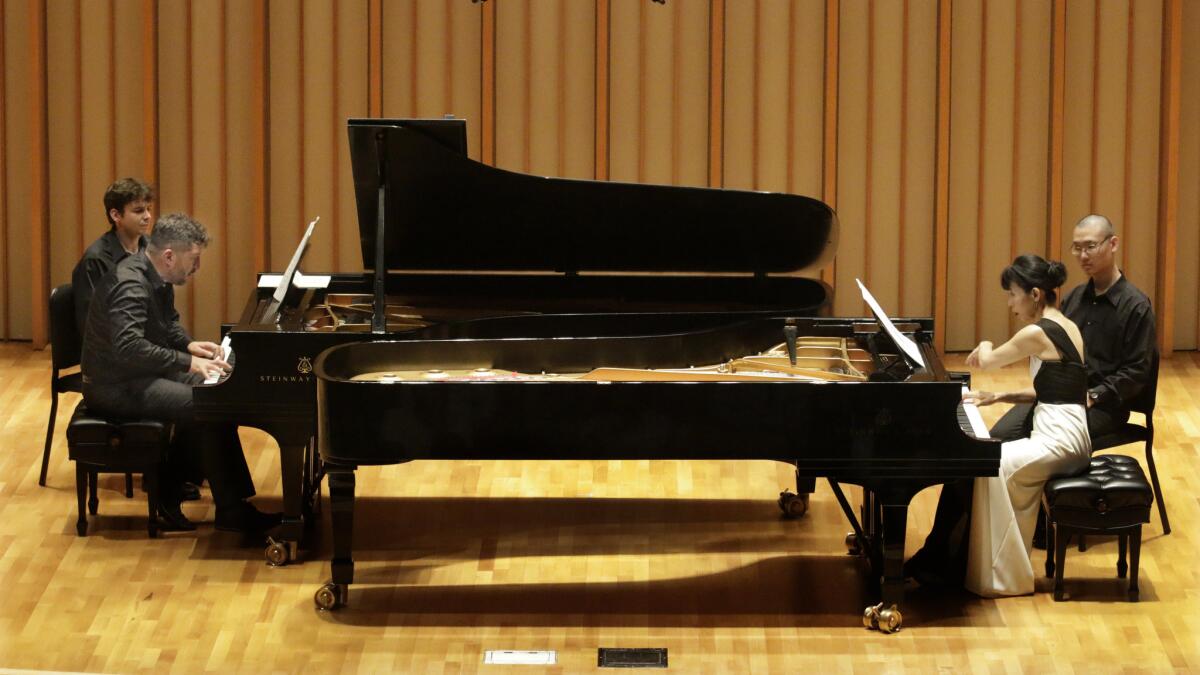Spectacular start to Piano Spheres’ 21st season

Thomas Ades and Gloria Cheng perform in a duo piano recital at Zipper Hall.
- Share via
Classical music’s fall season began on the dot, the day after Labor Day. Summer’s not over; Tuesday was, or at least felt like, the hottest day of the year. The Hollywood Bowl is still, this week, in business. The newspaper’s fall arts previews aren’t due until Sunday.
But here we are. Piano Spheres entered its 21st season spectacularly with a duo piano recital by one of the series’ founders, Gloria Cheng, and British composer Thomas Adès.
It included the season’s first premiere — Adès’ two-piano version of his Concert Paraphrase on “Powder Her Face,” commissioned for the occasion by Santa Monica arts patron Sue Bienkowski. The program was in general an illuminating investigation in modernist composers — Conlon Nancarrow, Ligeti and Messiaen — finding their groundbreaking voices. Adès himself was 24 when his first opera, “Powder Her Face,” was premiered in 1995.
SIGN UP for the free Essential Arts & Culture newsletter >>
The playing reached knock-your-socks-off proportions. The Colburn School’s Zipper Concert Hall was packed with a devoted audience for whom this was the Gloria and Tom Show, new music celebrities who are also members of a loyal local artistic community. Enthusiasm was contagious. At intermission and afterward, I was approached by people I knew and people I didn’t know wanting to make sure I understood, and could report, just how much this evening meant to them.
Can the first concert of a season that has jumped the fall gun already be a highlight?
Unlike most other musicians, pianists, when they partner, are either very close or very far apart. They sit side by a side at a single instrument, or when two pianos are involved, they face each other across the 9-foot divide of concert grands. In either case, they create the sound of a super piano. You can’t aurally tell who is playing what unless you watch them, since even with two pianos, the instruments are snuggled together (on recordings, however, they are usually artificially separated).
But they have their ways to interact, and distinctive personalities always emerge. In the case of Cheng and Adès, who have known each other for years (Cheng is one of the finest interpreters of Adès piano pieces) but who had never performed together, the impression was of opposites attracting.
Outwardly, Adès is a burly pianist with massive technique and magnificent sound for whom the keyboard seems a way to indulge in an appetite of sensuous pleasures. Underneath it all, though, is a rhythm wonk solving complex metrical equations.
Cheng, on the other hand, can always be counted on to meticulously elucidate a composer’s wishes — articulating every detail, figuring out every complexity, bringing a brilliant clarity to detail. Yet her secret weapon is a personal eloquence, along with a glamorous tone.
Together, Cheng and Adès played to each other’s inner, rather than outer, aspects. He counted as ferociously as she. She met him, head to head, in startling bruiser fortissimos.
Adès’ two piano arrangements of Nancarrow’s Studies Nos. 6 and 7 for player piano and of his original solo concert paraphrase of his opera framed the first half. In both cases, he opened up claustrophobic single-piano scores the way a splash of water will open up the flavor of a single malt Scotch.
The Nancarrow player-piano studies are not for humans. Here, though, four near superhuman hands can somewhat manage them. Even so, in the past, Adès relied on a recorded click track to help with Nancarrow’s machined rhythms. This time, there was no click track. Tempos were slowed and expressivity allowed.
In the simpler Study No. 6, Adès maintained a bass beat while Cheng articulated a deceptively lazy-sounding blues line above. The vastly complicated next study came alive with inner lines intertwining like a corps of dancers giving lucidity to geometrically abstract choreography.
The original “Powder Her Face” paraphrase adds Lizstian luster to four scenes of Adès’ sexually explicit, touchingly nasty opera about the scandals, the fun and the fall, of the Duchess of Argyll. If the solo paraphrase is a killer, the two-piano version doesn’t seem all that much easier — Adès has slightly paraphrased his original paraphrase. But the big difference is that it is now a drama. The two pianos do not portray individual characters, but there are two interpreters, and intriguing psychological ambiguities inevitably ensue.
In between, Cheng and Adès sat at a single piano for Ligeti’s five-minute 1950 Sonatina for piano four hands, a piece, playful and delightful, that showed the Hungarian composer on the cusp of discovering the avant-garde.
The second half of the program was devoted to Messiaen’s “Visions de l’Amen,” the French composer’s 1943 two-piano exercise, on the surface, of spiritual devotion to creation, the suffering of Jesus, the marvels of stars, angels and the stern judgment of God (in Messiaen’s music, not unlike that of a divorce judge in Adès’ opera shocked at the duchess’ sexual depravity).
But the heart of it is the “Amen of Desire,” at the center. Messiaen wrote it for himself on second piano and a young pianist who would become his wife on first. Cheng here took Piano 1 as she had with Vicki Ray at the Ojai Festival in June. Adès threw himself with obvious pleasure and next-to-no religiosity in the second piano. He was Messiaen, but bolder, as if updating the “Visions” just as he had his opera. Cheng met him with crystalline, unforgettable fireworks.
Twitter: @markswed
More to Read
The biggest entertainment stories
Get our big stories about Hollywood, film, television, music, arts, culture and more right in your inbox as soon as they publish.
You may occasionally receive promotional content from the Los Angeles Times.











